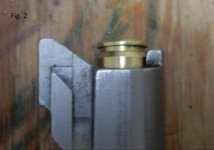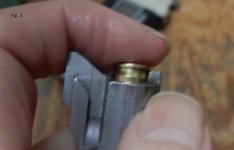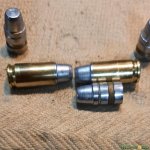Though I've been reloading well over 40 years, 9mm has been a problem to me. Some I can blame on short chambers but I've fixed most of the problems with my 'normal' loads of 125 gr coated SWC and plated bullets. So why am I running into trouble here?:
I'm loading 160 gr. bullets I had left over from an experiment some years back. I've got some LSWCHP and FN bullets. These are the flat nose. When trying for max loads with Unique and Acc. # 7 I had trouble compressing the loads that bulged cases and softer bullets that caused chambering problems. BUT I'M NOT DOING THAT now. I'm loading them with 4.2 grains of Titegroup so there is PLENTY of room in the case for the bullet. The bullets measure .355" dia. before and after seating. The gauge and the barrel both act similarly when plunking.
See Fig. 1, the finished cartridge:
The case O.D. measures good all the way up and the crimp is just enough to chamber good (I'm pretty sure about this, when I backed off the crimp a little, it wouldn't chamber) I'm using a Wilson 9mm case gauge and a barrel from a full size 3rd gen. for the plunk test.
See Fig. 2, the bullet plunked by gravity:
When I 'plunk' the bullet it stops and rides down slowly by gravity until it stops completely as shown.
See Fig. 3, Finishing the plunk by light pressure on the case:
Whatever is keeping the case from plunking completely by gravity feels SOFT. But when I press it a little, it sinks down to a a good plunk. Then I have to pull the cartridge out of the barrel or push it out of the gauge. Sometime when I turn the bullet and press it a few times, it gets to where it wil plunk completely, so it seems SOMETHING is being swaged a little when chambering. The rifling touching it perhaps?? But it isn't obvious from the surface of the bullet that it has been swaged against anything.
What do you all think??? Have you seen this when loading lead bullets?
I'm loading 160 gr. bullets I had left over from an experiment some years back. I've got some LSWCHP and FN bullets. These are the flat nose. When trying for max loads with Unique and Acc. # 7 I had trouble compressing the loads that bulged cases and softer bullets that caused chambering problems. BUT I'M NOT DOING THAT now. I'm loading them with 4.2 grains of Titegroup so there is PLENTY of room in the case for the bullet. The bullets measure .355" dia. before and after seating. The gauge and the barrel both act similarly when plunking.
See Fig. 1, the finished cartridge:
The case O.D. measures good all the way up and the crimp is just enough to chamber good (I'm pretty sure about this, when I backed off the crimp a little, it wouldn't chamber) I'm using a Wilson 9mm case gauge and a barrel from a full size 3rd gen. for the plunk test.
See Fig. 2, the bullet plunked by gravity:
When I 'plunk' the bullet it stops and rides down slowly by gravity until it stops completely as shown.
See Fig. 3, Finishing the plunk by light pressure on the case:
Whatever is keeping the case from plunking completely by gravity feels SOFT. But when I press it a little, it sinks down to a a good plunk. Then I have to pull the cartridge out of the barrel or push it out of the gauge. Sometime when I turn the bullet and press it a few times, it gets to where it wil plunk completely, so it seems SOMETHING is being swaged a little when chambering. The rifling touching it perhaps?? But it isn't obvious from the surface of the bullet that it has been swaged against anything.
What do you all think??? Have you seen this when loading lead bullets?
Attachments
Last edited:











